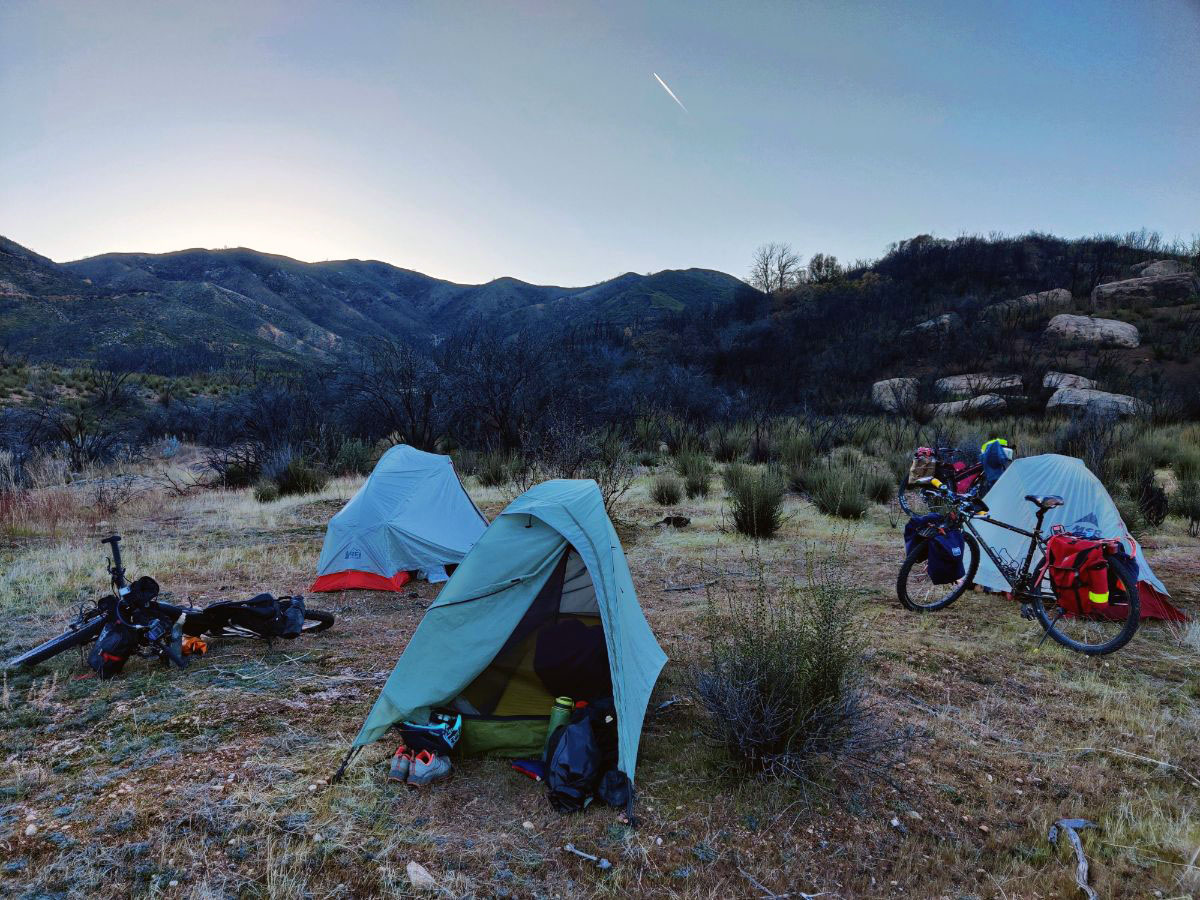Dispersed Camping for Cyclists
Imagine this: You’re pedaling a quiet dirt road through an endless pine forest as the afternoon sun sinks lower in the sky. You have no campground reservation or planned destination, but you’re not concerned. There are almost too many good camping options to choose from, but you’ll know the perfect one when you see it.
Just as your legs are feeling heavier and the air growing crisper, you spot it: an overgrown doubletrack leading off behind a small hill. You turn, follow, and there you are: a private clearing in the woods hidden from the road. You set up your shelter, cook dinner, and enjoy your home for the night, just you and the trees and a few small woodland critters. In the morning, you wake to the sound of birds, pack up your gear, and slip back to the dirt road to continue your journey.
This kind of camping is called dispersed camping, and if it sounds like a bike traveler’s idea of paradise, that’s because it is! Read on to learn where and how you can try dispersed camping on your next bike adventure.
What is dispersed camping?
In the U.S., “dispersed camping” means camping on federally managed public land away from developed recreation facilities. It’s most commonly allowed on land managed by the U.S. Forest Service (USFS) and the Bureau of Land Management (BLM). USFS land is often forested, hence the name national forest, while BLM land is usually desert or wide-open plains. Together they add up to 438 million acres — nearly 20 percent of the total U.S. landmass!
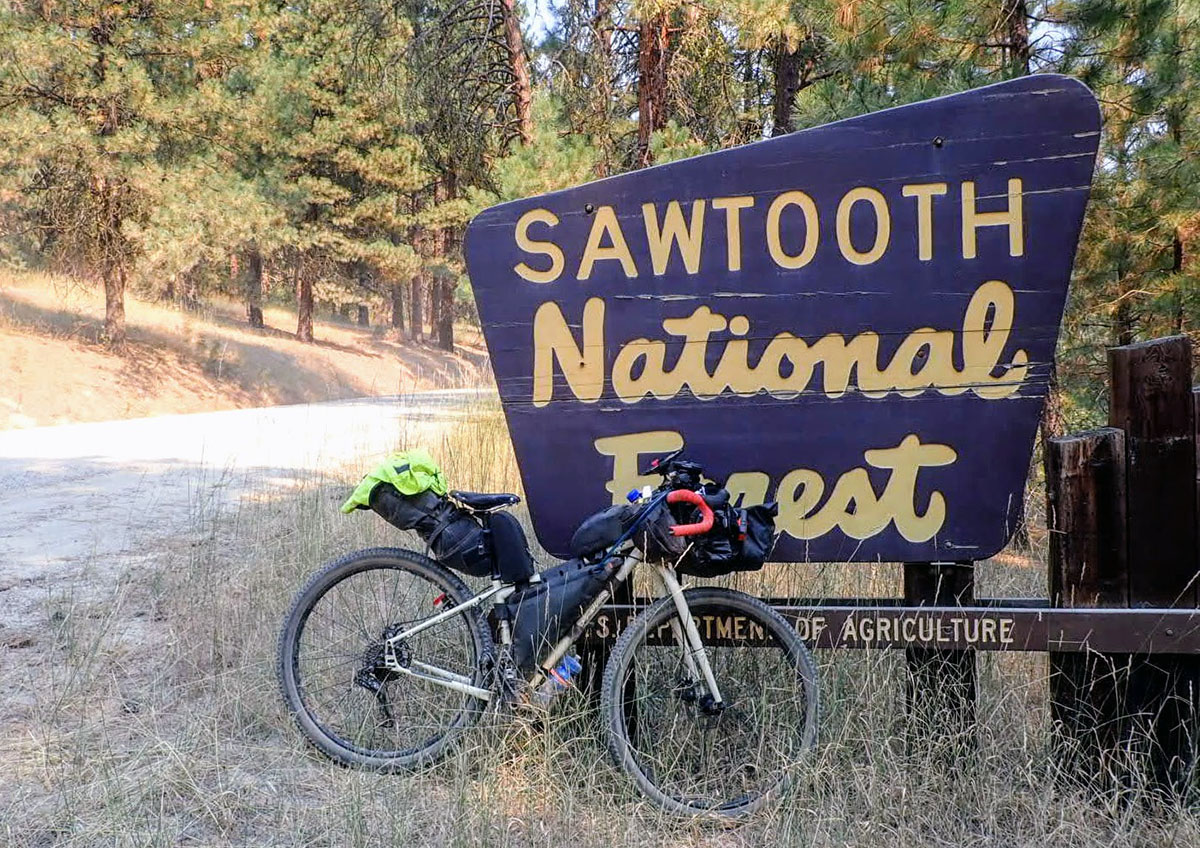
If you’re bikepacking in the western U.S., there’s a very good chance your route includes the potential for dispersed camping. The Great Divide Mountain Bike Route, for example, passes through more than a dozen national forests in its 2,700 miles. East of the Rockies, the options are more limited, but smaller patches of national forest can still be found. Dispersed camping works especially well for off-pavement bikepacking trips, but road tourers can find spots off main paved roads or a short distance down well-maintained gravel.
Enthusiastic bike travelers might be tempted to think this paradise exists mainly for us, but USFS and BLM land is managed for many uses including logging, mining, and cattle grazing. Even the outdoor recreation scene is diverse, and you’ll see far more car and RV campers, ATV riders, and hunters than cyclists out there. Though it’s not always a pristine wilderness, the sheer scale and accessibility of all this land makes for excellent bikepacking and dirt road touring.
Where is dispersed camping legal?
Generally speaking, dispersed camping is permitted in national forests and on BLM land where not prohibited. There are a few details that differ from region to region, so if you’re unsure, check the website or call the land management agency for the specific region you’ll be traveling in.
To find out where public land is and who manages it, check the USFS interactive map or BLM data viewer, or a land ownership layer in a mapping app like Gaia GPS, Trailforks, OnX, or a camping app like FreeRoam.
Generally, dispersed camping on public land is prohibited in these cases:
- Within 100 yards of a water source
- Within one mile of developed recreation areas including campgrounds, day use areas, and trailheads
- Anywhere else it’s specifically prohibited, usually to avoid conflict with other land users or damage to the ecosystem. For example, dispersed camping might be prohibited in a wildlife refuge or along a high-use road close to a small town.
- This won’t apply to cyclists on the move, but dispersed camping in a single site or area is usually limited to a maximum of 14 days out of any 30-day period.
Public land is often interspersed with private land, and it’s not always obvious where the boundaries are. You may find private ranchland alternating with BLM land in checkerboard parcels, or rural properties partly or even completely surrounded by national forest. Respect all fences and private property signs, even within an area you thought was public.
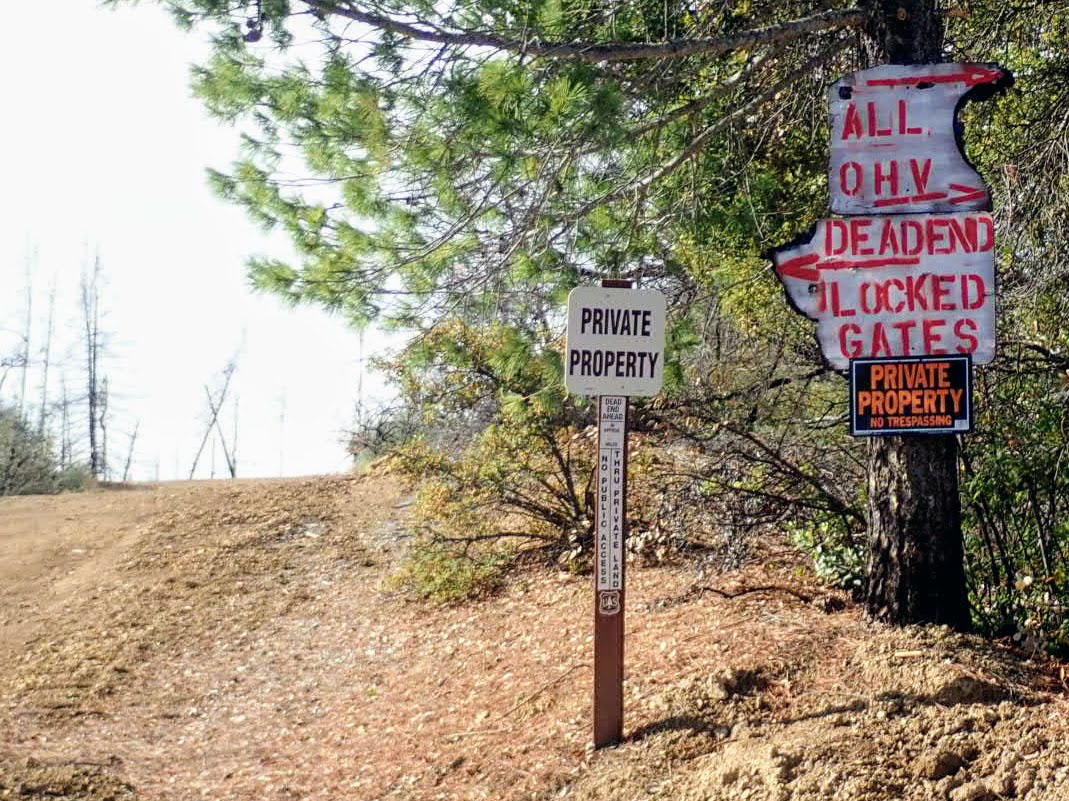
Though we sometimes refer to USFS and BLM land generally as “public land,” note that other types of public land don’t allow dispersed camping.
- National parks receive far too many visitors to make dispersed camping practical.
- State and regional parks all have their own rules but usually don’t allow camping outside of designated sites, if they allow it at all.
- Designated wilderness areas don’t allow bikes, period.
Finally, and significantly, remember that U.S. public land was home to Indigenous Peoples long before it came to belong to the U.S. government. Their past and current presence is an important part of the places we ride and camp. You can visit native-land.ca to learn about Indigenous territories corresponding to current public land boundaries. In some areas, you may encounter tribal land with its own rules and regulations, including some that apply to camping.
Pros and Cons
If you’re used to developed campgrounds, dispersed camping can be both liberating and a bit intimidating. Keep these points in mind as you weigh the options.
Advantages of dispersed camping:
- No cost
- Your own private spot
- No reservation needed
- Many options, allowing for a flexible ride-til-you’re-tired itinerary
- The fun and challenge of choosing the perfect site
Possible disadvantages of dispersed camping:
- No amenities. Don’t expect toilets, trash cans, showers, picnic tables, food lockers, or a camp host. You’ll have to take care of all your own needs while camping. More on that below.
- Dispersed sites are often dry, so you’ll have to carry all your water for the night and next morning.
- RV and car campers, ATVers, and hunters also love dispersed camping, so popular areas can be busy during holiday weekends or hunting seasons. Don’t be discouraged though, because a bicycle is perfect for finding out-of-the-way sites that bigger vehicles can’t access.
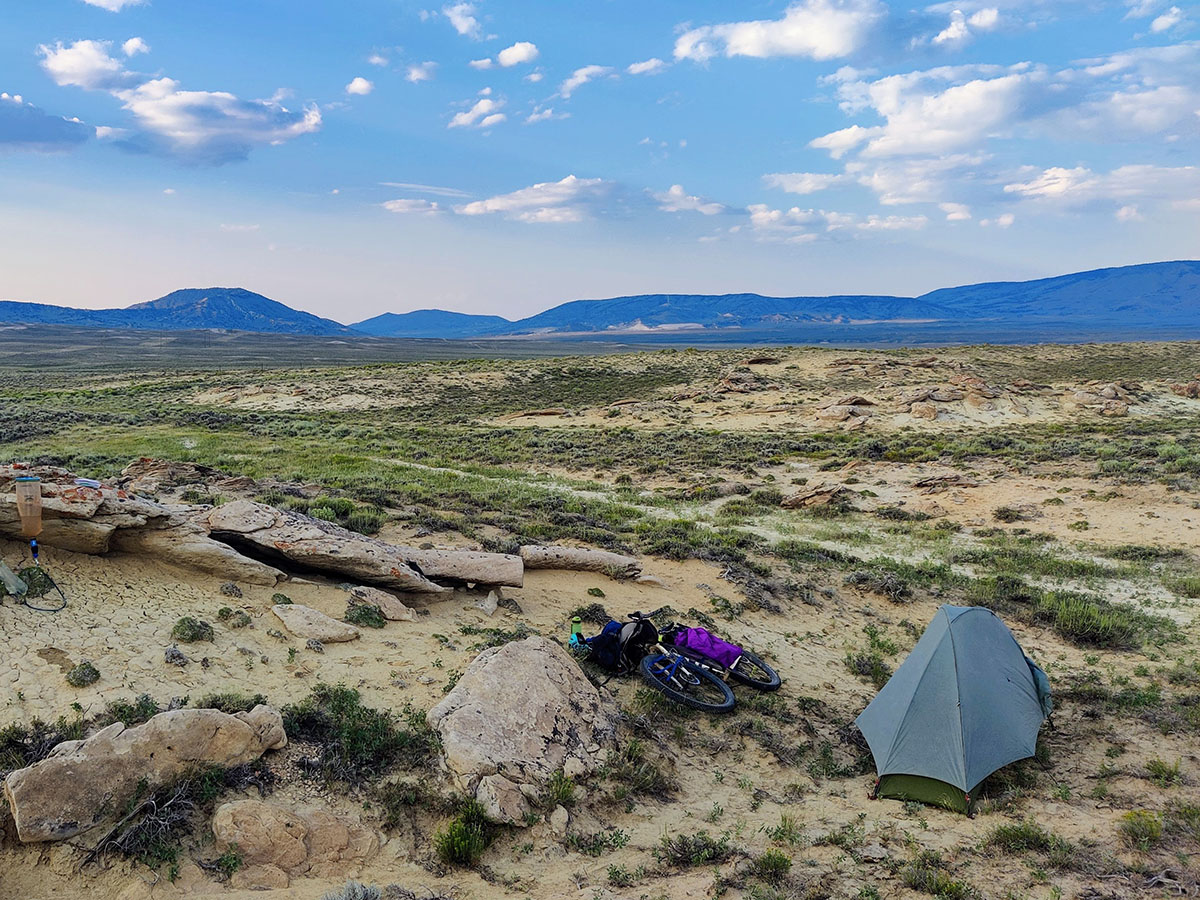
Choosing the Perfect Dispersed Campsite
When dispersed camping, you can’t simply ride into a campground and pick a numbered spot; you’ll need to put some thought into site selection. Keep these guidelines in mind.
Natural hazards
Avoid camping under or near dead branches or trees that could fall on your camp. Also avoid dry waterways, especially desert washes, which can flood quickly if it rains.
Comfort
Choose a level campsite if you want a good night’s sleep. Avoid low points in the topography, like the bottoms of valleys or canyons, if you’re concerned about cold temperatures overnight. If wind is an issue, look for shelter on the leeward side of a ridge, hill, boulder, or bushes. Late afternoon and early morning sunlight are always nice.
Stealthiness
Some dispersed campsites are simply pullouts beside a well-traveled road. Cyclists may want to skip these and seek out quieter sites down secondary roads or small tracks. It’s even okay to leave roads completely and head off into the woods or behind features in the terrain, as long as you can do so without disturbing fragile land and life (like cryptobiotic soil in the desert or fragile meadows in the alpine). If you do camp within sight of a road, the insides of curves and uphill are generally less noticeable than outsides and downhill.
Hunting Season Safety
A stealthy campsite may seem especially attractive during hunting season when public land is often busier, but it’s smart to make yourself visible when moving around off the road. “Blaze orange” is the traditional color for this purpose, but a high-vis cycling jacket should work too. As a ranger once advised, “Just don’t go running around in the woods acting like a deer and you’ll be fine.”
Mood
Spend a minute standing in the spot before committing. Does it feel right? You might not know you’re craving a lofty perch with a view or a cozy ring of trees until you take time to check in with yourself.
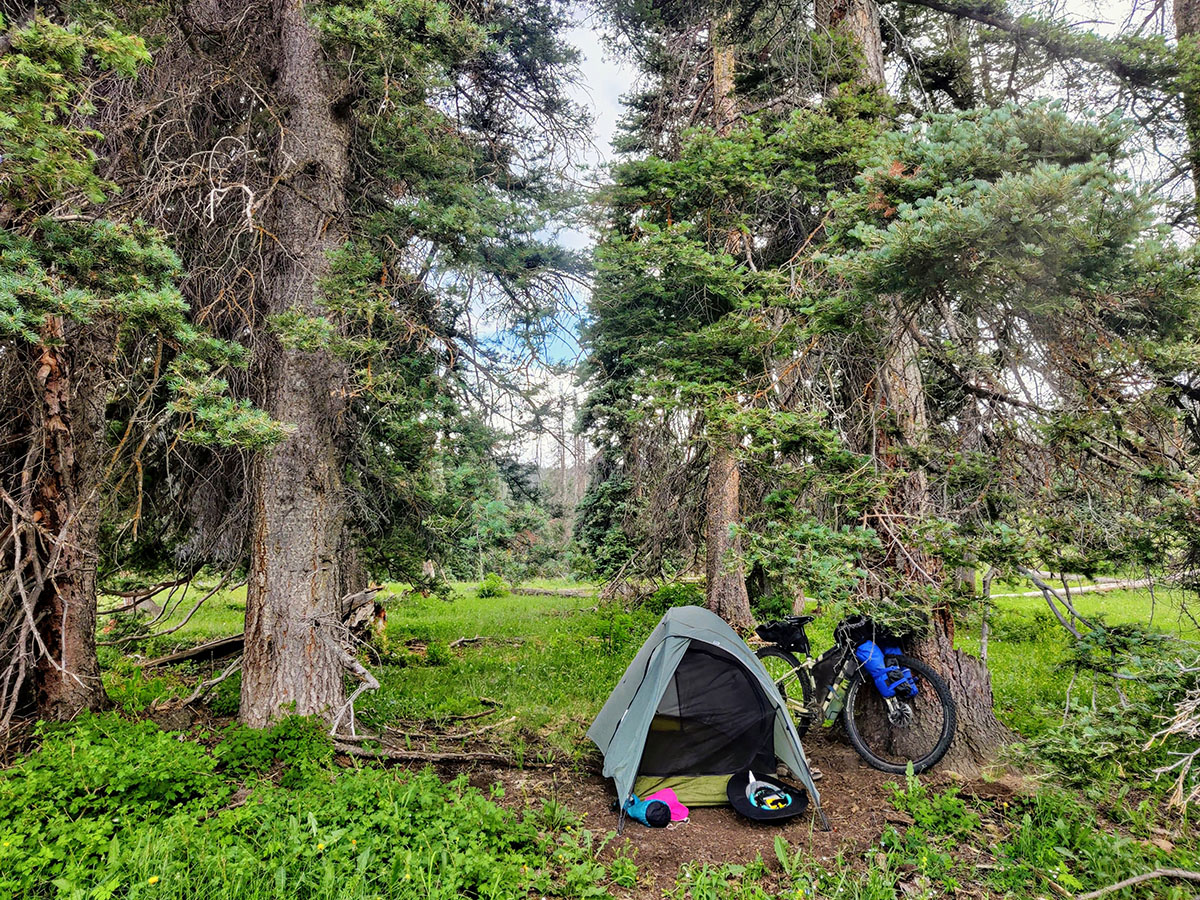
Camping Responsibly
Without amenities like toilets and trash bins, it’s up to us as campers to minimize our impact on the land and wildlife. Here are the key ways to Leave No Trace while dispersed camping.
Site Selection
Choose previously used sites where possible, or at least camp on durable surfaces like bare dirt to avoid damaging plantlife. Avoid camping right next to water sources, which pollutes them and deters thirsty animals from coming to drink.
Trash
Pack it out, every last bit. That includes food wrappers and plastic bags, but also less obvious materials like apple cores, orange peels, and peanut shells. Though these may technically be biodegradable, they take a very long time to disappear and they attract animals in the meantime.
Human Waste
There’s a bit of an art to pooping in the woods. It starts with digging a good hole at least 8 inches deep, at least 100 yards from any water sources, and somewhere it won’t accidentally be discovered by other campers. When finished, fill the hole completely and stomp it down with your foot to ensure your business is well and truly buried. Used toilet paper should be packed out in a ziplock bag (double bagged if you’re feeling squeamish about it), not buried.
Food and Wildlife
Proper food storage is essential when dispersed camping. Many national forests are in bear habitats, and rodents and other small mammals can be a major nuisance. Learn how to properly hang your food (it’s harder than you think) and/or carry an animal-resistant container like an Ursack. Keep a clean camp, pack out all food scraps (including those strained out of cooking and washing water) and cook at least 200 feet away from where you’ll sleep.
Washing and Water Sources
Water gives life to thirsty bikepackers and also to surrounding animals and plants. We can protect the entire ecosystem by never putting soap (even the “biodegradable” kind) or other chemicals directly in a water source. Carry wash water at least 200 feet from the source and do your washing and dumping there. This allows the wastewater to filter through the soil before rejoining the source, minimizing the impact of soap, sunscreen, bug spray, bike grease, food particles, or whatever else washed off your body, clothes, or dishes. Water and a good scrub work surprisingly well, but if you must use soap, make do with a small amount.
Fires
Several massively destructive wildfires have been caused in recent years by campers who lost control of their campfires. Especially when dispersed camping — where help and firefighting resources may be farther away — it’s critically important to be thoughtful about campfires and even camp stoves.
Follow these key guidelines:
- Check in advance for fire restrictions or bans, and observe them. Even if it’s not technically prohibited, common sense says a hot, windy day during a dry summer isn’t a good time to start a fire in the woods.
- If you do plan to have a campfire, choose a site with an existing fire ring instead of building a new one.
- Use only dead and downed wood as fuel so you don’t harm trees and the small animals that live in them.
- Never leave a fire or ashes unattended until the fire is completely out and all ashes are cool to the touch.
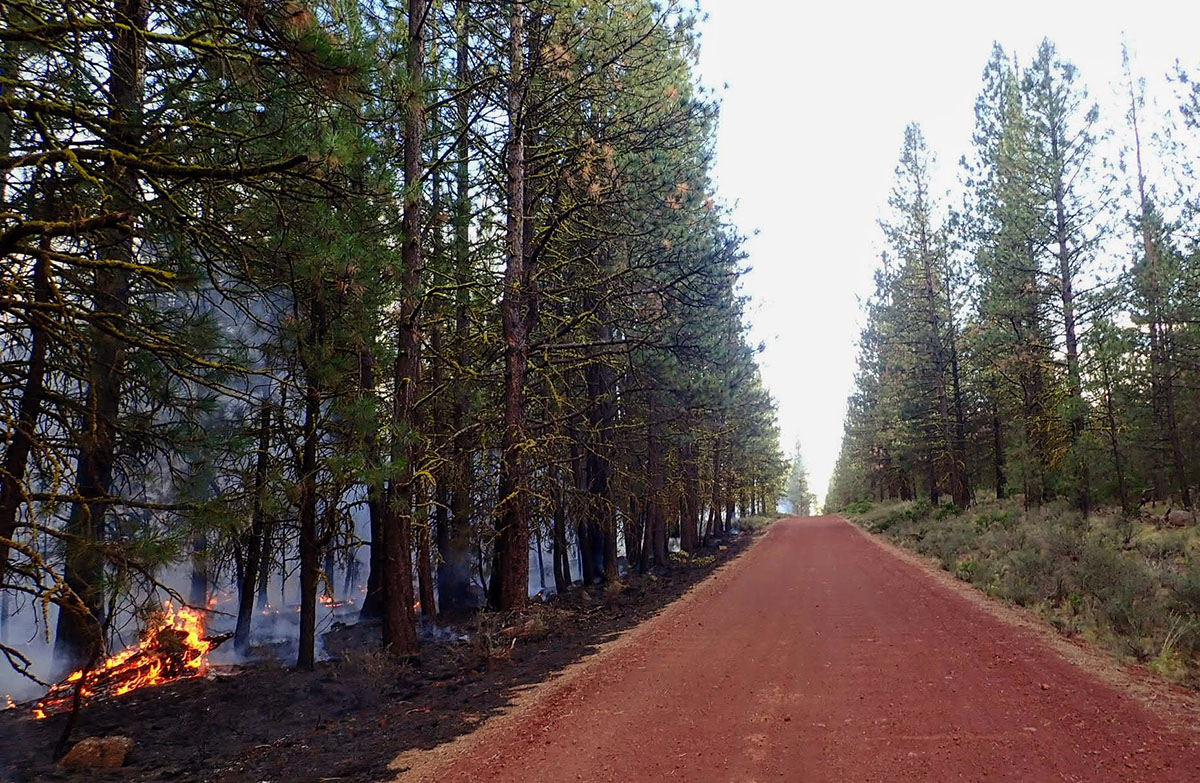
Happy Camping
Whether you’re looking to maximize peaceful time in nature or minimize your lodging budget, dispersed camping is a fantastic way to spend a few nights on your next bikepacking trip. The process of riding until you’re ready to stop, choosing the perfect spot, and taking responsibility for protecting the land adds a certain organic feel to a self-propelled journey. Explore, enjoy, and sleep well in your peaceful, private spot as you appreciate America’s vast public lands.
